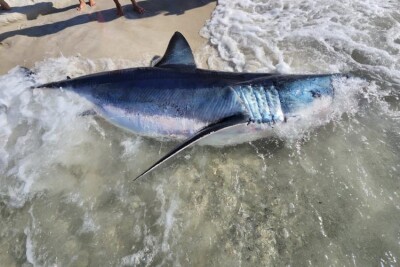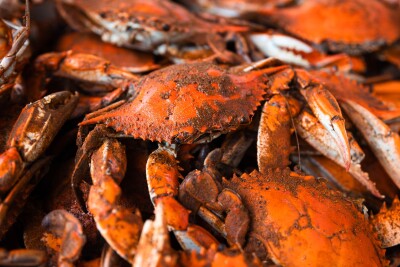Northeast
Containership rams scalloper; repairs will take three months
After being towed from Dorchester Shipyard in Maurice River Township, Marlton, N.J., the 71-foot scalloper Dictator was hauled out at Fairhaven Shipyard Companies in Fairhaven, Mass. Other than a bent-up outrigger and some damaged transom plating, she looked fine above the waterline. Below the waterline, it was a different story.
To start with, the Dictator's prop was mangled, the rudder shaft was bent over, half the Kort nozzle was missing, and the keel was three feet out of alignment to the starboard. The damage is "rather significant," says the boatyard's Kevin McLaughlin. Besides the damage that was visible from the outside, McLaughlin notes that the shaft, intermediate shaft, engine and transmission suffered enough damage that they must be replaced.
The engine and gear were shoved forward and knocked off the engine beds, says the boat's owner Tim Harper in Southwest Harbor, Maine.
The missing parts of the Kort nozzle and the plate the rudder pivots in won't be found on the ocean floor. They punched their way into the bulbous bow of the 965-foot containership Florida in a nearly fatal collision with the Dictator early in the afternoon on April 14, 40-some miles off Cape May, N.J.
"The bulbous bow had three good holes poked in it," Harper says. "One was pretty big; they said you could crawl through it."
Injuries among the crew included "four broken ribs, bruises, and one guy had his head split open," Harper says.
The Dictator and about 50 other scallopers were working an area closed to groundfishing but open to scallopers. Visibility was limited by heavy rain and fog. Harper was told, "it was a 10-knot zone because it was a whale zone, and the boat that hit us was going 18 knots.
"The mate didn't see it until the last moment and had the boat wide open and turning hard trying to get away from it. If he hadn't, then the [Florida's] bulbous bow would have gotten underneath the towing wires because they had the gear down and would have pulled the boat down.
"He turned it hard enough for the cables to go slack under the boat. That saved them," Harper says.
A mayday went out. Other scallopers responded, but the Florida didn't reply.
By the third week in May the Dictator had been at Fairhaven Shipyard for about three weeks, and it was not expected to go into the water for another two months. The boatyard's crew was sandblasting the inside of the scalloper, had machined a new shaft log and had plating for a new keel. The original keel has to be removed from the fish hold aft and a new rudder tube fabricated, McLaughlin says.
A new main engine is going into the boat. It's the same as the old engine, a 540-hp Caterpillar 3412.
Something Harper doesn't understand is why he has heard so little about the accident.
"I'm really disgusted with my insurance company guy and the Coast Guard. I get nothing out of them, very little. They give me a crumb here and there. I haven't seen any kinds of reports — nothing," he says.
(To make up for the lack of information, Harper would like fishermen to e-mail him regarding near misses with ships: [email protected].)
Harper wonders if another boat might have gone down after being hit. He's referring to the New Jersey scalloper Lady Mary that sank March 24. Six crewmen died.
"A diver sent me some pictures [of the Lady Mary] and the damage to the rudder looks quite similar to the damage on the rudder of my boat," he says.
The Dictator was built at the LaForce Shipyard (now Raymond & Associates) in Bayou La Batre, Ala., in 1988 or 1989, says Harper, for offshore longlining with a Honduras flag. The boat came back to the United States and was rebuilt for scalloping. The owner couldn't pay the yard bill and the boat was auctioned off. (A spokeswoman at Raymond & Associates says Ray LaForce can't remember a boat being built for a Honduras owner and couldn't say for sure without seeing it if his boatyard built the boat. — Michael Crowley
West
Boat repair business is back; 125-footer fires four engines
For the owner of a wooden commercial fishing boat that needs work, the Port of Port Townsend, Wash., is a go-to place. Several boatshops specialize in repairing wooden boats, and there are metalwork, engine and electronics outfits. When fishermen make money, plenty of boats are in for new planks, frames, a top-house, repowering, whatever is needed to keep a fishing boat going.
But when times are lean, there aren't so many boats, which has been the case the past few years. However, this winter and spring things were different.
More fishermen have been "making money and getting their boats worked on," says Chris Chase with Port Townsend Shipwrights Co-op, one of the yards specializing in wooden boats.
"The whole Port Townsend yard was just chock-a-block full of commercial boats. It really made the season for all the wood boatyards. There was a lot of commercial work: seiners, longliners, packers and trollers.
"It was really nice to come out of the pub and look across the yard and see trolling poles as far as the eye could see. I haven't seen that in a really long time."
One of the boats worked on at Port Townsend Shipwrights Co-op was the Copasetic, a 58-foot wooden limit seiner built in 1977 and owned by Tim and John Wilkie of Seward, Alaska.
The boat received new bulwarks, a top-house, a refrigerated seawater system, hydraulics and electrical systems, and a new main engine.
The Copasetic was repowered with a 400-hp Volvo Penta D12. New exhaust and cooling systems were required, though the shafting and marine gear was retained. However, new fuel tanks were needed, which required the last 20 feet of the Alaska yellow cedar deck to be pulled up and replaced.
The boatshop teamed up with two other Port Townsend companies to work on the Copasetic. Steelhead Marine did much of the aluminum work on the bulwarks and top-house, and Integrated Marine Systems provided the RSW system.
Another Alaska seiner that was hauled was the Johnny B, built in 1929. "We hung 20 planks on her below the waterline and sistered some frames," says Chase. "A young guy bought it to fish Southeast [Alaska]. It's an older boat, but a great starter boat."
Two 42-foot Washington trollers in for repairs were the Maui and the Karol Lee. The Maui got a lot of new planking and some frames, and the hull was recaulked and refastened. The Karol Lee had her guards replaced and some caulking work done.
Larch was used for the planking, which Chase says is used more and more as Douglas fir is harder to come by. The density is about the same for the two woods, while larch is more rot resistant.
At Hansen Boat Co. in Everett, Wash., a couple of large steel boats were in for major work. The 125-foot freezer-longliner Bounty Bay got four new Cummins QSK19 engines. A pair of them (750 hp each at 1,800 rpm) replaced two main engines and two replaced the engines on generator sets.
New Fernstrum keel coolers were installed, and most of the exhaust system was replaced, though the mufflers were reused, says the boatyard's Dan Campbell. Since the shafting was showing a lot of wear, it was also replaced.
Other work included new fire-suppression and CO2 systems, and the freezer holds were modified.
The 115-foot crabber Ocean Fury was dry-docked for steelwork. A small section of rusted hull plating in the stern had to be replaced. A void area in the transom for unused fuel tanks had never been painted, and there was corrosion, Campbell says.
"As we were pressure washing getting ready to paint, we blew a hole through the plating, and that had to be replaced," he explains.
The steel deck under the galley also had corrosion problems. The boat was built in the 1970s and the deck had a cement underlayment that hadn't been maintained.
"It was just wasting away, and the washing machine was actually starting to fall through into the engine room," Campbell says. With the deck completed, new cabinets and galley equipment were being put in.
The refrigeration company Teknotherm was supplying a new RSW system.The Beauty Bay was due to leave the last week of May and the Ocean Fury in July. — Michael Crowley
South
Oysters get refrigerated barge; old horn timbers are leakers
Pete Nixon of Norfolk, Va., builds fiberglass fishing boats. He is also in the oyster aquaculture business and plans to build a barge for his oyster business.
He and a partner grow oysters in cages for the summer half-shell restaurant market in Norfolk and Virginia Beach.
The tourist trade fuels this half-shell market. That makes it a warm-weather business, which creates harvesting issues; the oysters must be iced down on the boat or oystermen have to knock off by 10 a.m. After that it's too hot to have oysters onboard.
Nixon plans to build a 36' x 12' barge out of C-Flex fiberglass with a hold where either ice or refrigeration will keep his oysters cool. This will allow him to work the oyster beds throughout the hottest part of the season.
"We want to be able to use the barge as a work platform all day. Also, some of our beds are in extremely low tidal areas where we have to go in when the tide is right and leave when it's right, which means we have to be there for a while," Nixon says.
"When the tide goes out, we will use the barge as a work platform, and as soon as the tide comes in, we will use it to carry our payload back to the dock," he adds.
The recession has hurt Nixon's boatbuilding business. Inside his shop, there is a nearly completed recreational boat that was being built for a customer who worked at an automobile plant in Norfolk. The plant closed, leaving the man without a job and Nixon with a spec boat.
Since he was 13 years old, Wilmore Hogge, 64, of Hayes, Va., has been working the water. That has taught him a lot about fixing wooden boats.
Hogge is dredging oysters on the James River, but his ability to fix bad leaks recently had him over in Urbanna, Va., working on a deadrise boat.
Rufus Ruark Sr., of Shores and Ruark Seafood in Urbanna, needed a leak fixed on the 42-foot Honey, an older workboat with a two-piece horn timber.
The Achilles heel of deadrise workboats like the Honey is the horn timber. It ties the keel and transom together, with the propeller shaft running down through it.
A reverse curve in the horn timber gives a boat a concave bottom in the stern sections. This feature helps to keep the stern down, just touching the water, and makes the boat lie level in the water. Over time, water can penetrate the seams where the horn timber is fastened together. The modern one-piece horn timber was a remedy for this problem.
The seams in the Honey's old-style horn timber had been leaking for some time. Hogge had to refit the horn timber, caulk the seams, and replace a portion of the bottom to stop the leaking.
"I'm not a number one when it comes to working on wooden boats, but I've learned what I know from working on my own boats," he says.
"It's watermen like Wilmore who have a learned knowledge and skill of fixing boats that we are turning to more and more to keep the bay's commercial fleet going.
"It used to be there was a wooden boatbuilder or a boatyard that catered to wooden boats in every little community, but that's just about gone," Ruark says.
Edwards Marine Railway is one small boatyard that still caters to wooden boats. The boatyard's Bobby Edwards is replacing the bottom on a 16-foot Lewis Wright–built deadrise skiff. It is used for gillnetting and crab potting and is powered by an 18-hp outboard.
Edwards is rebuilding the deadrise and cross-planked bottom with Canadian spruce pine. Lewis Wright built boats for commercial fishermen in Deltaville, Va., from 1916 until he died in early 1990s.
Edwards also has a 1979-vintage recreational wooden deadrise on the rails that was the last deadrise built by the late Alton Smith of Mathews County, Va.
Smith learned the trade from his father, Lennie, and Lewis Wright learned from his father, Tom. Both Lennie Smith and Tom Wright were pioneers in the construction of deadrise and cross-planked boats.
When you work on their boats, you can see the skill of those two boatbuilders," says Edwards. "Wright and Smith were top of the line." — Larry Chowning






